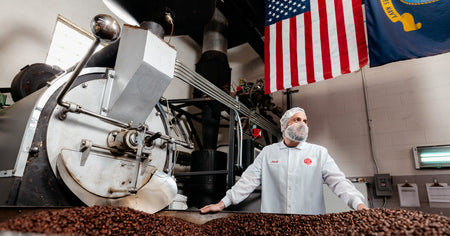November 18, 2020
What is agitation when it comes to coffee? Well, our first thought is actually the state of anxiety that we experience when we run out of it.
However, coffee agitation is also a trick that can make or break your pour over brew. After all, why would you want to drink a mediocre cup when you can brew barista-worthy coffee with just a simple extra step?
What is agitation in coffee?
Agitation or turbulence is a gentle disturbance of the coffee bed which consists of shuffling the grounds during the brewing process.
Why bother?
If you’ve recently started using a manual pour over like the Hario V60 or the Chemex, you’ve probably already figured it out: while more control over the brewing process can unlock more flavors, there’s also more room for mistakes.
Don’t let it discourage you!
If your brew didn’t turn out as tasty as you wished, it might very well be because of agitation. Or, better: the lack thereof.

The secret to a perfect cup of joe is consistency. If your grounds are extracted at different times, you’ll get a mixture of under-extracted (weak and sour) and over-extracted coffee compounds (stronger and bitter). The result? A messy cup of mediocre joe.
This usually happens because of a tricky issue called channeling. Water always looks for the easier way out, making its way down the coffee bed through the route with the least resistance. If the coffee grounds aren’t even or don’t all get covered in water, the ones closer to these channels will be more extracted than the farthest ones.
In a nutshell, by agitating your pour over coffee you avoid channeling and can guarantee an evenly extracted cup of joe.
How to agitate pour over coffee

Agitating pour over coffee isn’t actually as complicated as this fancy word makes it sound and you can choose the method that works best for you!
Stir the coffee with a spoon
The easiest, sounds-too-good-to-be-true method!
Just stir the coffee grounds after pre-wetting them (before they start to bloom) and after you’ve poured all the water, making sure that they’re all submerged.
This method is especially practical if you’re using a small pour over brewer like a Kalita Wave.
Swirl your pour over coffee maker
This fancier method is one of the go-to choices of many baristas and professional coffee aficionados. It works particularly well with larger pour overs like the biggest Hario V60 models or the Chemex.
Hold it tight and swirl it in a circular motion (after pre-wetting the grounds and after the final pour), being careful not to spill its precious content.
Agitate the coffee bed while pulse pouring
Have a firm grip on your gooseneck kettle and pour the water in a strong, circular motion, but only in small increments.
By doing this (pulse pouring, if you were after your second fancy word of the day), you’re going to keep the coffee bed low and consistent, preventing the grounds from sticking to the side of your paper filter.
Flush the coffee
Not down the toilet! This technique simply consists of pouring the last milliliters of water along the top edges of your filter, sending those stubborn grounds back into the coffee bed.
However, we don’t recommend doing this with the Kalita Wave since, given the peculiar shape of its wavy filter, the water could ‘bypass’ the coffee.
Not too hard, right? So, what is agitation? Definitely not an advanced technique reserved for barista champions. We think it’s just a simple trick to really make the most of your Fire Dept. Coffee when you brew with a manual pour over!
Leave a comment
Comments will be approved before showing up.
Also in Fire Department Coffee News

Celebrating America’s Firefighting Presidents

Fire Department Coffee and Kidde Working Together to Promote Fire Safety

From Barista to Coffee Expert: Fire Dept. Coffee's Jacob Ball Brews Success

Get to Know the Hilarious, Hardworking Team Behind FDC Videos

From Fan to Family: How Lance Woodruff Became an FDC Star

Marine, Musician, Firefighter: Josh Kennedy is Doing It All

January's Coffee of the Month Club Kickstarts a Journey to 100% Direct Trade Coffee

FDC Mobilizes Rosenbauer Fire Truck for Tennessee Tornado Relief

Fire Dept. Coffee's First Retail Shop Opens in Rockford, IL

Sugar Cookie Rum Infused Coffee - Spirit Infused Coffee Club

Fire Dept. Coffee Bound for Walmart Shelves After Open Call Event

Raising Our Mugs for Firefighter Appreciation Month
FOLLOW OUR JOURNEY, GET SPECIAL OFFERS AND PROMOTIONS
- SPIRIT INFUSED COFFEE
- Bourbon Infused Coffee
- Whiskey Infused Coffee
- Rum Infused Coffee
- Tequila Infused Coffee
- Spirit Infused Coffee Club
- Spirit Infusion Process
GEAR
© 2025 Fire Department Coffee, Inc.











